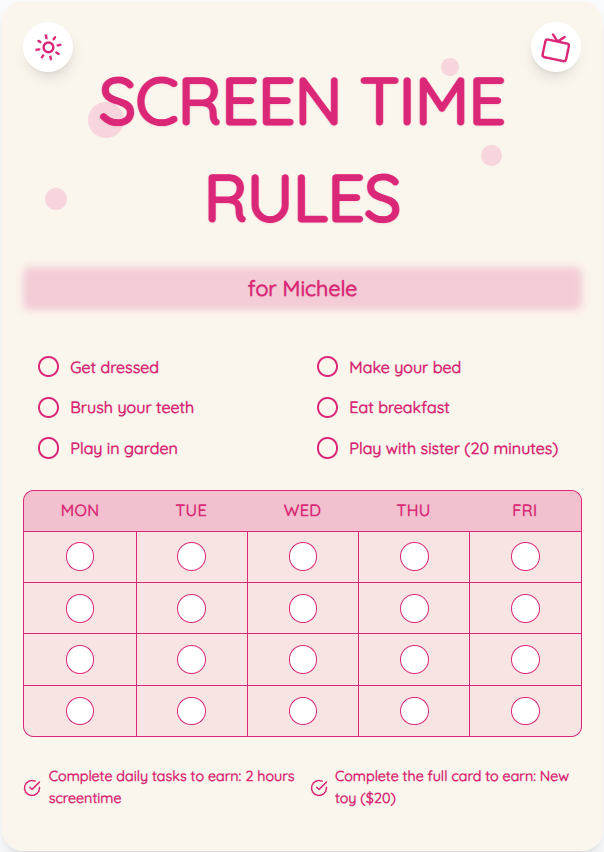Screen Time Management: Navigating 3 Hours a Day for Kids
As a parent, striking a balance with your child's screen time can be challenging. With children spending more time on screens than ever before, understanding how to manage 3 hours of screen time a day is crucial for their well-being and development. In this guide, we'll provide you with actionable advice and practical tips to help you create a healthy screen time routine that fosters child development and family harmony.
See What Your Screen Time Chart Will Look Like
Here's an example of a beautiful, customizable screen time rules chart you can create for your family

Setting Clear Guidelines
Establishing clear rules and guidelines around screen time is essential. Create a daily schedule that includes designated screen time blocks. Communicate these guidelines effectively to your child, emphasizing the importance of balance between screen activities and other enriching experiences like outdoor play, reading, and family time.
Exploring Interactive Screen Time
Not all screen time is created equal. Encourage your child to engage in interactive and educational content rather than passive viewing. Look for apps, games, and programs that promote learning, creativity, and problem-solving skills. Using screen time charts can help you track and limit recreational screen time while maximizing educational opportunities.
Put These Tips Into Action
Create a custom chart to implement these strategies with your child
Encouraging Offline Activities
Balance is key when it comes to screen time. Encourage your child to participate in offline activities that promote physical activity, social interaction, and creativity. Set aside time for arts and crafts, outdoor play, sports, or family outings to ensure a well-rounded childhood experience.
Practical Tips for Success
- Create a visual screen time chart for easy monitoring.
- Engage in screen time activities together as a family.
- Set screen-free zones in the house like the dining area or bedrooms.
- Use screen time as a reward for completing chores or homework.
Frequently Asked Questions
How can I limit my child's screen time without constant battles?
Establishing a consistent routine and using visual aids like screen time charts can help set clear expectations. Engage your child in the process by explaining the reasons behind screen time limits and involving them in creating a balanced schedule.
What are the signs of excessive screen time in children?
Signs of excessive screen time may include irritability when screens are taken away, difficulty focusing on non-screen activities, disrupted sleep patterns, and social withdrawal. Monitoring your child's behavior and mood can help you identify any negative effects of excessive screen time.
How can I encourage my child to choose non-screen activities?
Lead by example and participate in offline activities with your child. Provide a variety of engaging alternatives such as board games, puzzles, outdoor adventures, or creative projects. Praise and reward your child when they choose non-screen activities over screen time.
By implementing these practical tips and strategies, you can effectively manage your child's 3 hours of daily screen time while promoting their overall well-being and development. Remember, moderation is key when it comes to screen time. Explore the use of screen time charts from ScreenTimeRules.com to simplify the process and create a healthy tech balance for your family.
Ready to Transform Your Family's Screen Time?
Join thousands of parents who have successfully managed screen time with our customizable charts.
